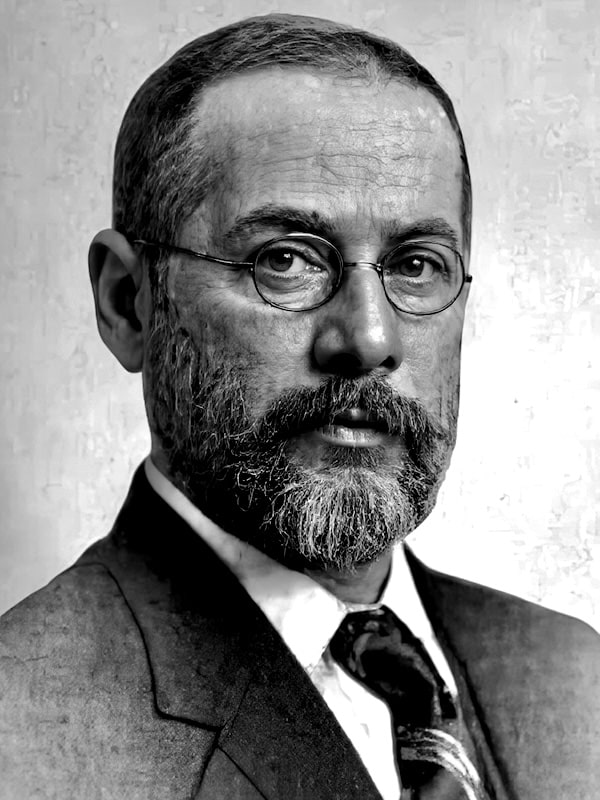Frederick Forchheimer

Frederick Forchheimer (1853-1913) was an American pediatrician
Forchheimer was an educator, and pioneering paediatrician, best known for describing Forchheimer spots—enathematic lesions seen in rubella. A native of Cincinnati, he helped elevate the medical stature of his hometown through clinical innovation, prolific scholarship, and leadership in American internal medicine.
Graduating from the College of Physicians and Surgeons in New York at the age of 20, Forchheimer studied further in Vienna before returning to Cincinnati. There, he founded one of the earliest children’s clinics in the United States and rapidly rose through the academic ranks at the Medical College of Ohio.
He held professorships across disciplines—chemistry, physiology, paediatrics, and medicine—and published extensively, culminating in the encyclopedic Therapeusis of Internal Diseases (1913). A respected diagnostician and therapeutic thinker, his influence extended nationally through his leadership of the Association of American Physicians and his widely used textbooks.
Beyond medicine, Forchheimer was also a gifted violinist and part of Johannes Brahms’ musical circle during his time in Vienna. His rich dual legacy—both scientific and artistic—embodied a classically holistic vision of human potential.
Biography
- 1853 – Born September 25 in Cincinnati, Ohio.
- 1873 – Graduated with a medical degree from the College of Physicians and Surgeons in New York at age 20.
- 1873–1875 – Undertook postgraduate study in Europe, particularly in Vienna; developed friendships with Johannes Brahms (1833–1897), Eduard Hanslick (1825–1904), Joseph Joachim (1831–1907), and Theodor Billroth (1829–1894).
- 1875 – Returned to Cincinnati; appointed instructor at the Medical College of Ohio.
- 1876 – Began teaching as demonstrator of morbid anatomy and histology.
- 1877 – Appointed professor of chemistry at the Medical College of Ohio.
- 1880 – Appointed professor of physiology and clinical pediatrics.
- 1885 – Married Edith S. Perry; had three children.
- 1892 – Published Diseases of the Mouth in Children, describing Forchheimer spots.
- 1900 – Succeeded James T. Whittaker as professor of practice at the Medical College of Ohio.
- 1906 – Published The Prophylaxis and Treatment of Internal Diseases; widely recognized and successful.
- 1907 – Released the expanded Forchheimer’s Therapeusis of Internal Diseases with contributions from multiple specialists.
- 1911 – Elected President of the Association of American Physicians.
- 1912 – Awarded honorary Doctor of Science by Harvard University.
- 1913 – Edited and published Therapeusis of Internal Diseases through Appleton.
- 1913 – Died June 1 at Jewish Hospital in Cincinnati following prostate surgery; buried at Spring Grove Cemetery.
Medical Eponyms
Forchheimer spots (1898)
1898 – Forchheimer reviewed the world literature on enanthem (rash on the mucous membranes) to differentiate rubella from scarlet fever. He found no conclusive evidence in the literature quoting Jürgensen (1896) “an enanthem may be present – it may be absent…“.
During May 1898, Forchheimer examined 22 cases during a rubella epidemic documenting a consistent enanthem appearing simultaneously with the exanthem. His first patient was his 11 year old son:
…a macular, distinctly rose-red eruption upon the velum of the palate, the uvula, extending to but not on to the hard palate. These spots were arranged irregularly, not crescentically; were the size of large pin-heads, were very little elevated above the level of the mucous membrane, and did not seem to produce any reaction upon it. Six hours after this, the enanthem had become decidedly paler, the infiltration very much less, and by the next morning it had disappeared.
The claim that this enanthem is distinctive can be defended by comparison with the enanthem of those two diseases with which rubella is confounded.
In scarlatina the enanthem appears from twelve to twenty-four hours before the eruption; it appears on the pillars of the fauces in the form of the characteristic puncta, then rapidly spreads over the mouth in the form of a scarlet red coalescing eruption, which finally ends in desquamation and lasting well into the second week of the disease.
In measles the enanthem begins upon the soft palate from thirty-six to forty-eight hours before the exanthem, in the form of purplish or bluish papules, arranged crescentically, extends over the cheeks , accompanied by the blue tongue; it is at its maximum with the beginning of the eruption and may take as long as three or four days to disappear.
It will be seen, therefore, that in all respects does the enanthem of rubella differ from that of scarlatina and measles, and when seen can be utilized with certainty for differential diagnostic purposes.
Forchheimer 1898

Major Publications
- Hofman KB, Ulzmann R. Guide to the examination of urine : with special reference to the diseases of the urinary apparatus. Translated by Forchheimer, 1879 2e
- Forchheimer F. The diseases of the mouth in children (non-surgical). 1892
- Forchheimer F. The enanthem of German measles. Transactions of the American Pediatric Society 1898; 10: 118-128 [Forchheimer spots]
- Forchheimer F. The prophylaxis and treatment of internal diseases designed for the use of practitioners and of advanced students of medicine. 1906 (2e 1910)
- Forchheimer F. Therapeusis of internal diseases. 1913 [Volume 1; Volume 2; Volume 3; Volume 4]
References
Biography
- Frederick Forchheimer, 1853–1913. Boston Med Surg J 1913; 169:71-72
- The passing of Frederick Forchheimer. The American Israelite, Cincinnati, Ohio05 Jun 1913
- Juettner O. Frederick Forchheimer. Transactions of the American Therapeutic Society 1914: 17-19
Eponymous terms
- Fukuda M, Harada T, Shimizu T, Hiroshige J. Forchheimer Spots in Rubella. Intern Med. 2020 Jul 1;59(13):1673.
Eponym
the person behind the name
British doctor currently working in Emergency Medicine in Perth, Australia. University Leicester 2019 (MBChB). Keen on a career in geriatrics/palliative care but currently being indecisive about which country to start training in!
BA MA (Oxon) MBChB (Edin) FACEM FFSEM. Emergency physician, Sir Charles Gairdner Hospital. Passion for rugby; medical history; medical education; and asynchronous learning #FOAMed evangelist. Co-founder and CTO of Life in the Fast lane | On Call: Principles and Protocol 4e| Eponyms | Books |

